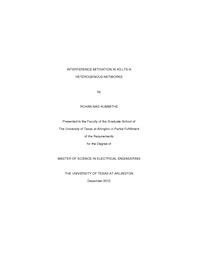
ATTENTION: The works hosted here are being migrated to a new repository that will consolidate resources, improve discoverability, and better show UTA's research impact on the global community. We will update authors as the migration progresses. Please see MavMatrix for more information.
Show simple item record
| dc.contributor.author | Kummithe, Rohan Nag | en_US |
| dc.date.accessioned | 2013-07-22T20:14:28Z | |
| dc.date.available | 2013-07-22T20:14:28Z | |
| dc.date.issued | 2013-07-22 | |
| dc.date.submitted | January 2012 | en_US |
| dc.identifier.other | DISS-12058 | en_US |
| dc.identifier.uri | http://hdl.handle.net/10106/11858 | |
| dc.description.abstract | Long Term Evolution (LTE) complements 3G networks with high data rates, low latency and a flat, IP-based architecture. It also allows operators to use a new and a much wider spectrum when compared to the previous standards. To further enhance this and to achieve the constraints set by the International Mobile Telecommunication-Union (IMT-U), 3GPP has been working on various aspects of the LTE-Advance standard which has been officially termed as 4G network.Apart from the enhancements in the radio link, the next performance leap in wireless networks will come from an evolved network topology. The concept is to improve spectral efficiency per unit area. Using different combinations of femto cells, relays and pico cells, heterogeneous networks can provide the optimal experience to the user. The drawback to all this is that there will be severe interference between various components in the heterogeneous networks. Furthermore, as the femtocells are user deployed, the interference management schemes become even more important. These interference mitigation techniques also need to counter the interference between network components macrocell and femtocell in a heterogonous network. To counter the above mentioned problems, to increase the throughput and to meet the data rates set by the standard, technologies such as Carrier Aggregation (CA) and Coordinated Multipoint transmission/reception (CoMP) have been defined.In this thesis an implementation of the technologies CA and CoMP have been proposed to target the performance of 4G networks. This has been implemented in a macrocell-femtocell network for the downlink transmission. This coordination improves the quality of the received signal and also increases the capacity of each user thus increasing the capacity of the entire system. | en_US |
| dc.description.sponsorship | Liang, Qilian | en_US |
| dc.language.iso | en | en_US |
| dc.publisher | Electrical Engineering | en_US |
| dc.title | Interference Mitigation In 4g LTE-A Heterogenous Networks | en_US |
| dc.type | M.S. | en_US |
| dc.contributor.committeeChair | Liang, Qilian | en_US |
| dc.degree.department | Electrical Engineering | en_US |
| dc.degree.discipline | Electrical Engineering | en_US |
| dc.degree.grantor | University of Texas at Arlington | en_US |
| dc.degree.level | masters | en_US |
| dc.degree.name | M.S. | en_US |
Files in this item
- Name:
- Kummithe_uta_2502M_12058.pdf
- Size:
- 666.0Kb
- Format:
- PDF
This item appears in the following Collection(s)
Show simple item record


